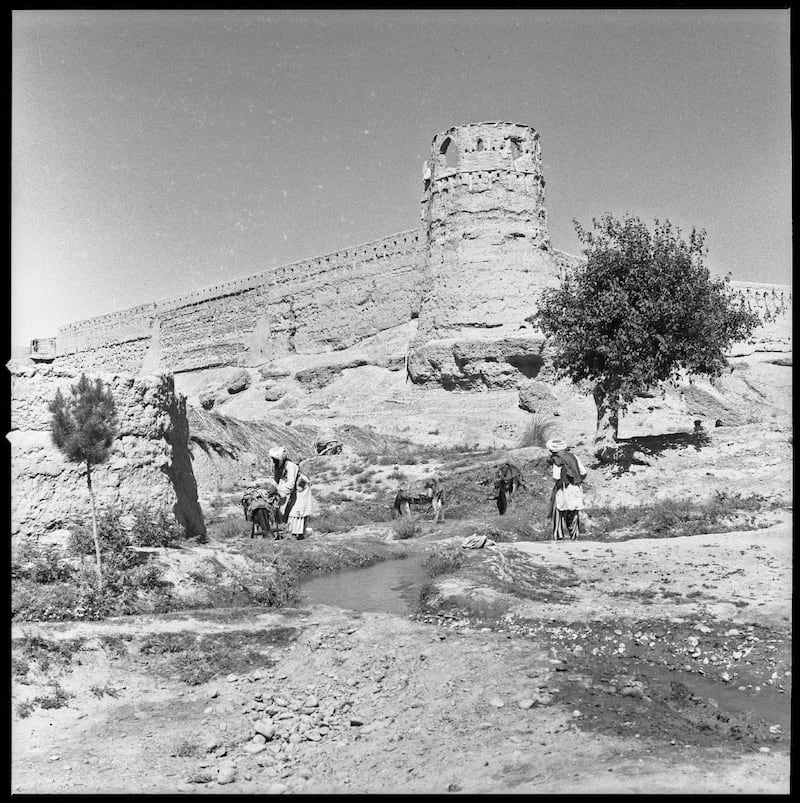Parts of a 170-year-old fort in the Gereshk district of Helmand were demolished last week by Taliban fighters, witnesses on Friday told The National.
“In the last two days, we have seen them [the Taliban] destroy part of the Bala Hisar. When we enquired they told us they want to build a madrassa [religious school] in its place,” said Ahmadullah Rafiq, 25, a student from Helmand.
Most of the main wall on the outside of the fort was torn down using a bulldozer, eyewitnesses said. Only a part of the tower remains, because demolition was stopped before the machine reached it.
The Taliban, who took control of Afghanistan after the fall of the capital Kabul on August 15, have a long history of destroying historical structures they deem to be un-Islamic.
Pictures of Bamiyan’s famous Buddha statues being blasted to rubble by Taliban munitions 20 years ago are etched in the memories of locals and heritage enthusiasts around the world. The group also destroyed archaeological artefacts in the National Museum in Kabul during their last regime from 1996-2001.
But Taliban officials have denied being involved in the demolition of the Gereshk fort and say they have ordered the destruction to stop.
“This is a historic fort, dating back to almost 170 years and it is a part of Afghanistan. The news of its destruction came to our elders and we ordered it to stop,” said Ahmadullah Wasiq, Taliban’s culture committee deputy.
Situated in the heart of Gereshk, the fort is a significant historical landmark for the locals in Helmand, Mr Rafiq said.
“These are not just buildings but our history. It was passed down to us from our ancestors. We should be proud of it, and not destroy it,” said Mr Rafiq, whose name has been changed to protect his identity.
Local historian Mujtaba Mohammadi said the fort is of important historical significance..
“The fort, located close to the Helmand river, a very beautiful neighbourhood, was built during the first Anglo-Afghan war between 1839 and 1842,” he said.
“It was named after Timurlane of the Timur Empire, and was the centre of the resistance against the British under the rule of Ghazi Mohammad Ayub Khan. Some of the strongest fights were managed from this fort,” he said.
In later years, under King Amanullah Khan in the early 1900s, it was used as a Karwan-e-Saray, where travelling traders would spend the night while passing through the region, once part of an important trade route.
“There are many similar forts in the area, a very historical neighbourhood, that were used by traders including Bost,” he said, referring to another historical monument close by.
But the structures have fallen into disrepair in recent decades as war raged around them, and have also been used by various powers without restoration. “The previous government used it as an army base, and before that it served as a prison,” Mr Rafiq said.
Mr Mohamnadi, who also works in the local Department of Culture, expressed dismay over the disregard for Helmand’s historical culture.
“At the department, we would receive many complaints over the mismanagement of such forts. People would do agriculture inside it and allow water to clog.
He said the nearby Bost fort and the land surrounding it had been taken by local residents and even as an army bast by the Afghan government.
“Everyone is trying to loot historical sites. Either they don’t know the history or even if they do, it doesn’t matter to them,” he said.
While Mr Mohamnadi appreciated the Taliban’s quick response in stopping the demolition of the Gereshk fort, he urged the group, which now controls much of Afghanistan, to take proactive steps to restore historical structures.
“These forts don’t just belong to the people of Gereshk but to all of Afghanistan. It is the duty of every Afghan to protect their history,” he said. “Under the previous government, there were plans to renovate it in the coming years, but unfortunately over 50 per cent of this fort has now been destroyed,” he said.
“Any historical monument represents our identity and values. It is the Taliban’s responsibility to not only protect and restore them [but to] prevent further destruction of our identities,” Mr Mohamnadi said.
Mr Rafiq agreed. “I am not against building madrassas. But we have so much unused land; they can build two, even three madrassas there. What is the need to destroy our history?” he said. “This is a reminder of how our ancestors fought bravely for the values of freedom."





